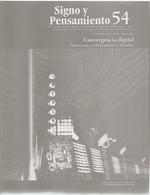Resumen
Al alba de la Sociedad de la Información, el constante proceso de digitalización transforma nuestras actividades diarias. Este cambio sucede con tal velocidad que a menudo nos impide detenernos a reflexionar sobre su origen y trascendencia. Mientras articulamos nuevos espacios digitales, acrecentamos la brecha digital; las posibilidades de beneficiarse de la sociedad de la información se reducen. Sin embargo, a la vez tendemos puentes que permiten superar la brecha, cimentados en la convergencia de tecnologías y de contenidos. Este artículo explora la relación entre la brecha y la convergencia digital, e invita al lector a reflexionar sobre estos puentes digitales, muestras efectivas del aprovechamiento de las tecnologías de información y comunicación en la educación, la cultura, la salud y la sociedad.
Batista, E. (2008), “She’s Gotta Have It: Cell Phone” [en línea], disponible en: http://www.wired. com/culture/lifestyle/news/2003/05/58861, recuperado: 6 de junio de 2008.
Castells, M. (2004), “The Network Society: a Cross-Cultural Perspective”, Northampton, MA: Edward Elgar.
CEA-UIIA (2008), “Centro de Estudios Ayuuk” [en línea], disponible en http://cea-uiia.blogspot. com/, recuperado: 11 de octubre de 2008.
— (2006), “Hacia dónde vamos: un diagnóstico de la región Mixe”, Oaxaca, México, Sistema Universitario Jesuita/cdi.
— (2007), “Modelo educativo” [documento de trabajo], Oaxaca, México. Coyle, K. (2007), “Digital Divide”, The Journal of Academic Librarianship, núm. 33, pp. 708- 709.
Crispín Bernardo, M. L. (2006), “Formación de profesores universitarios para el desarrollo de las habilidades necesarias para el aprendizaje autónomo desde una perspectiva intercultural” [proyecto de investigación], México, Universidad Iberoamericana.
Cullen, R. (2001), “Addressing the Digital Divide”, en Online Information Review, pp. 311-320.
Engelbrecht, H. J. (2008), “Internet-Based ‘Social Sharing’ as a New Form of Global Production: The case of seti@home”, en Telematics and Informatics, núm. 25, pp. 156-168.
Gil, G. (2003), “Discurso do ministro Gilberto Gil na solenidade de transmissão do cargo”, Brasilia, s. e.
Gilleard, C. y Higgs, P. (2008), “Internet Use and the Digital Divide in the English Longitudinal Study of Ageing”, en Eur J Ageing, núm. 5, pp. 233-239.
Instituto Nacional de Estadística Geografía e Informática (INEGI) (2005), “Información estadística sobre la sociedad de la información” [en línea], disponible en http://www. inegi.gob.mx, recuperado: 12 de octubre 2008.
International Telecommunication Union (ITU) (2003), “World Telecommunication Development Report 2003. Access Indicators for the Information Society”, Geneva, International Telecommunication Union (ITU).
— (2007), “Measuring the Information Society”, Geneva, International Telecommunication Union (ITU).
Jeon, S. (2008), “Strategic implications of the open market-paradigm under digital convergence: the case of small business C2C”, en Service Business, núm. 4, pp. 321-334.
Kydd, A. (2007, julio), “Entrevista sobre el Proyecto Zumbido”, s. d.
Martínez, L. M. (2008), “Reporte de visita a los puntos de cultura del Ministerio de Cultura de Brasil” [documento de trabajo], México, Departamento de Comunicación, Universidad Iberoamericana.
National Telecommunications and Information Administration (2000), “Falling Through the Net: Toward Digital Inclusion: A Report on Americans’ Access to Technology Tools” [en línea], disponible en http://www.ntia. doc.gov/ntiahome/fttn00/contents00.html, recuperado: 7 de julio de 2008.
Ojanper, T. (2006), “Convergence Transforms Internet”, en Wireless Personal Communications, núm. 37, pp. 167-185.
Organización de las Naciones Unidas (ONU) (2008), “Sitio web de las Naciones Unidas para los indicadores de los objetivos de desarrollo del milenio” [en línea], disponible en http://mdgs. un.org/unsd/mdg/Home.aspx, recuperado: 12 de octubre de 2008.
Rivera, A. (2008), “Ambientes digitales de aprendizaje y la colaboración intercultural” [en prensa], DIDAC.
Sciadas, G. (ed.) (2005), From the Digital Divide to Digital Opportunities: Measuring Infostates for Development, Montreal, Orbicom.
Secretaría de Economía de Oaxaca (2008), “Oaxaca en cifras” [en línea], disponible en http://economia.oaxaca.gob.mx/index.php?s eccion=cifras&id=geografia, recuperado: 12 de octubre de 2008.
Sta. le Angen Rye (2008), “Exploring the gap of the digital divide. Conditions of connectivity and higher education participation”, en GeoJournal, núm. 71, pp. 171-184.
Esta revista científica se encuentra registrada bajo la licencia Creative Commons Reconocimiento 4.0 Internacional. Por lo tanto, esta obra se puede reproducir, distribuir y comunicar públicamente en formato digital, siempre que se reconozca el nombre de los autores y a la Pontificia Universidad Javeriana. Se permite citar, adaptar, transformar, autoarchivar, republicar y crear a partir del material, para cualquier finalidad (incluso comercial), siempre que se reconozca adecuadamente la autoría, se proporcione un enlace a la obra original y se indique si se han realizado cambios. La Pontificia Universidad Javeriana no retiene los derechos sobre las obras publicadas y los contenidos son responsabilidad exclusiva de los autores, quienes conservan sus derechos morales, intelectuales, de privacidad y publicidad.
El aval sobre la intervención de la obra (revisión, corrección de estilo, traducción, diagramación) y su posterior divulgación se otorga mediante una licencia de uso y no a través de una cesión de derechos, lo que representa que la revista y la Pontificia Universidad Javeriana se eximen de cualquier responsabilidad que se pueda derivar de una mala práctica ética por parte de los autores. En consecuencia de la protección brindada por la licencia de uso, la revista no se encuentra en la obligación de publicar retractaciones o modificar la información ya publicada, a no ser que la errata surja del proceso de gestión editorial. La publicación de contenidos en esta revista no representa regalías para los contribuyentes.


